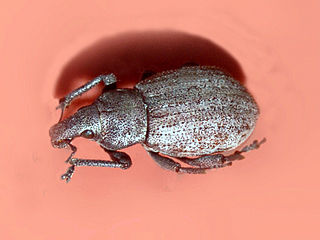
Calosoma is a genus of large ground beetles that occur primarily throughout the Northern Hemisphere, and are referred to as caterpillar hunters or caterpillar searchers. Many of the 167 species are largely or entirely black, but some have bright metallic coloration. They produce a foul-smelling spray from glands near the tip of the abdomen. They are recognizable due to their large thorax, which is almost the size of their abdomen and much wider than their head.

Anisodactylus is a genus of ground beetle native to the Palearctic, the Near East and North Africa. It contains the following species:

Calosoma elegans is a species of ground beetle in the family Carabidae. It is found in Kazakhstan, Kyrgyzstan, and China.

Carabinae is a subfamily of ground beetles in the family Carabidae. There are about 10 genera and more than 1,400 described species in Carabinae. The Carabinea include 2 tribes, the Cychrini Laporte, 1834 and Carabini Latreille, 1802. The Carabini Latreille is divided into 2 sub-tribes, the Carabina Latreille, 1802 and Ceroglossina Vacher de Lapouge, 1927.

Calosoma retusum is a beetle of the family Carabidae.

Carabus morbillosus is a beetle of the family Carabidae.

Calosoma calidum is a species of ground beetle in the subfamily of Carabinae. It was described by Johan Christian Fabricius in 1775. It occurs throughout Canada and the northern and eastern parts of the United States. About 19mm to 27mm long, this beetle is black with rows of red or gold spots or pits on its elytra. It can be found in fields and disturbed habitats. Larvae and adults prey upon moth caterpillars.
Calosoma catenatum is a species of ground beetle in the family Carabidae. It is found in Kenya.
Calosoma ewersmanni is a species of ground beetle in the family Carabidae. It is found in Turkey.
Calosoma latipenne is a species in the beetle family Carabidae. It is found in the United States.

Calosoma maderae is a species of ground beetle in the subfamily Carabinae which is 25 to 35 millimetres long. It was described by Johan Christian Fabricius in 1775 and is found in Europe, North Africa and Asia.
Calosoma masaicum is a species in the beetle family Carabidae. It is found in Kenya.

Calosoma panderi is a species of ground beetle in the family Carabidae. It is found in Kazakhstan, Kyrgyzstan, and Russia.

Calosoma usgentense is a species in the beetle family Carabidae. It is found in Uzbekistan and Kyrgyzstan.

Barynotus is a genus in the weevil family (Curculionidae).

Mecaspis is a genus of cylindrical weevils belonging to the family Curculionidae. This genus is present in most of Europe, in the East Palearctic realm, in the Near East and in North Africa.

Chelymorpha is a genus of tortoise beetles and hispines in the family Chrysomelidae. There are more than 70 described species in Chelymorpha.
Calosoma breviusculum is a species of ground beetle in the family Carabidae. It is found in Turkey, Georgia, Armenia, Iran, and Azerbaijan.













